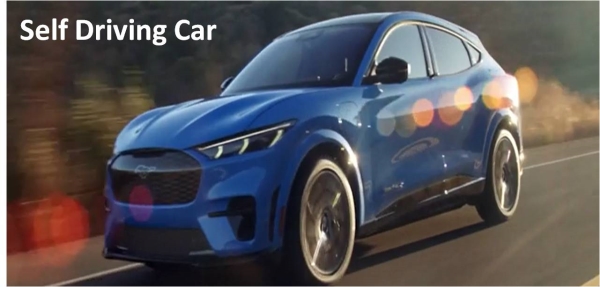Cognitive Lrn&Shr
Latest News / Articles
Self-driving cars are one of the hottest topics in the world of tech right now.If cars can drive themselves and use advanced tech to avoid accidents entirely, seems too nice

Credits : https://edition.cnn.com
Now, we stand to witness the next transportation revolution with the advent of self-driving cars.
Self-driving vehicles have the potential to improve safety and reshape cities to transport people more efficiently. But to reach that future, we have work to do. Public and private stakeholders, including rideshare companies, public transit operators and local, state and federal governments must work together to create consistent industry regulations and streamline the testing and deployment of autonomous vehicles.
Early on, Lyft was on the front lines, working with local, state and federal regulators to introduce ridesharing to cities and towns across the country -- many of which were governed by a patchwork of rules.
For example, when Lyft introduced the Amp, a light-up device that better connects riders to their corresponding vehicle, its deployment was delayed in the greater Washington DC metropolitan area. because regulations in Virginia did not align with those of Maryland and DC, and rides often span across the region. Our subsequent work with Virginia's legislature and governor's office helped enact legislation to allow drivers to use Amp and expand statewide safety measures.
We worked collaboratively with policymakers and regulators as we aim to solve complexities in the system and create a better experience. By working to create consistent regulations from one region to the next, we have the potential to aid safe deployment of self-driving technologies.
Consistent industry standards and government regulations for safety are also key to the future of autonomous vehicle deployment. That is why we recently joined the Automated Vehicle Safety Consortium, a first-of-its-kind coalition of leading automotive manufacturers and tech companies working to create automated driving system technology, designed to share key insights and best practices that can help shape safety standards.
Consistent safety regulations help protect consumers by assuring that new technologies are safe, and regulatory consistency allows developers to deploy that safety to the broadest population.
This applies to consistency in laws, too. Traffic laws, for example, can vary from one municipality to the next, making it more difficult to design, test and validate autonomous vehicles for widespread use. A less subjective and conflicting system of traffic laws and rules of the road would help improve the safety of our roadways for both human drivers and self-driving cars while also providing developers with clear objectives for designing law-abiding automated driving systems.
Consider, too, the impact of infrastructure. Local governments play an integral role in owning and operating public rights of way and transportation infrastructure. Improvements and consistency in road signage, markings and pavement conditions, as well as better maintenance of surrounding roadway environment -- including trees, shrubs and drainage and storm water systems -- will support the safe operation of autonomous vehicles. Autonomous vehicles need to be able to recognize aspects of a changing environment - like bushes obscuring or growing into lanes and trees changing with the seasons -- to navigate potential obstacles when needed.
Cities can also begin to think about allocating certain streets or travel lanes to dedicated modes of transportation such as people-centric boulevards for walking, bike and scooter lanes, transit-only lanes, and even AV-only routes. And automated driving systems can be further enhanced by providing operational information from roadway infrastructure, such as traffic signal phase and timing and warning for a red light violation or a pedestrian in a crosswalk. These features can make trips safer and faster for both passengers and pedestrians, but it will require public-private collaboration to make them a reality.
Self-driving vehicles could operate as low-speed shuttles to and from transit centers in urban environments, create mobile convenience centers for work and generally open new mobility opportunities for communities across the country. But to complete driverless first- and last-mile connections to transit, industry will need to work with the public sector to create pro-innovation regulatory frameworks.
States that have adopted consistent regulations need to invite innovation. Florida, for example, now governs its 412 municipalities with the same set of driving regulations, which offers consistency and clarity for autonomous vehicle companies. States that lean in to innovation can attract companies to safely test AVs and open opportunities for the public to begin to experience and familiarize themselves with self-driving technology by passing legislation to allow AVs to be offered on rideshare platforms -- with many similar insurance and regulatory requirements as existing transportation network companies.
By inviting and supporting innovation with streamlined regulations, all state's residents and economies stand to benefit.
Ultimately, standards for AV safety should be decided by the federal government based primarily on voluntary industry standards and input from academia, industry and safety organizations on best practices. It is critical that we avoid a patchwork of safety standards that vary from state to state, as this will come at the cost of innovation and of making technology and safety advancements on autonomous vehicles.
Self-driving vehicles will no doubt change the face of America, but no single company or government will be responsible for the deployment of AVs -- it will require a shared vision and public-private collaboration. Cities, states and the federal government are critical partners to achieving the safety and societal benefits of an autonomous future. They all play an important role in upgrading infrastructure, modernizing laws and creating a pro-innovation environment to advance the development and deployment of automated driving systems.
Source: https://edition.cnn.com
Share This:
Read all Latest Online Learning Resources News
Source: https://edition.cnn.com
Copyright © 2018 Cognitive Lrn&Shr . all rights reserved.